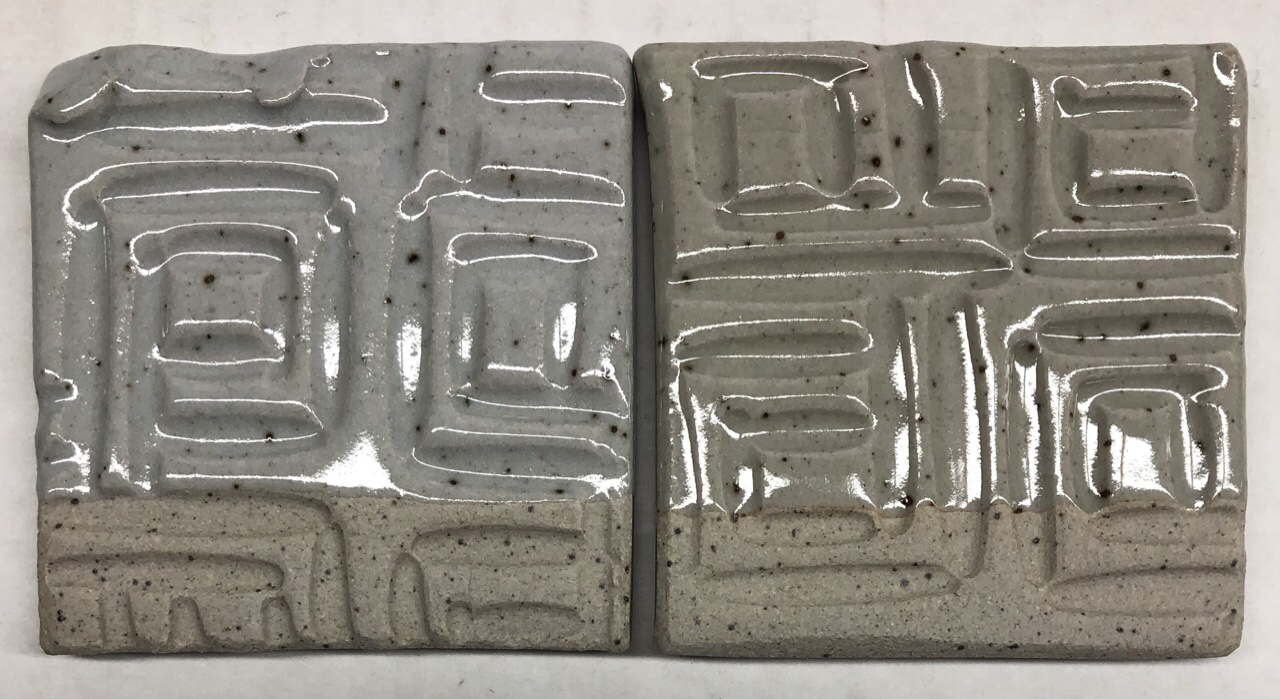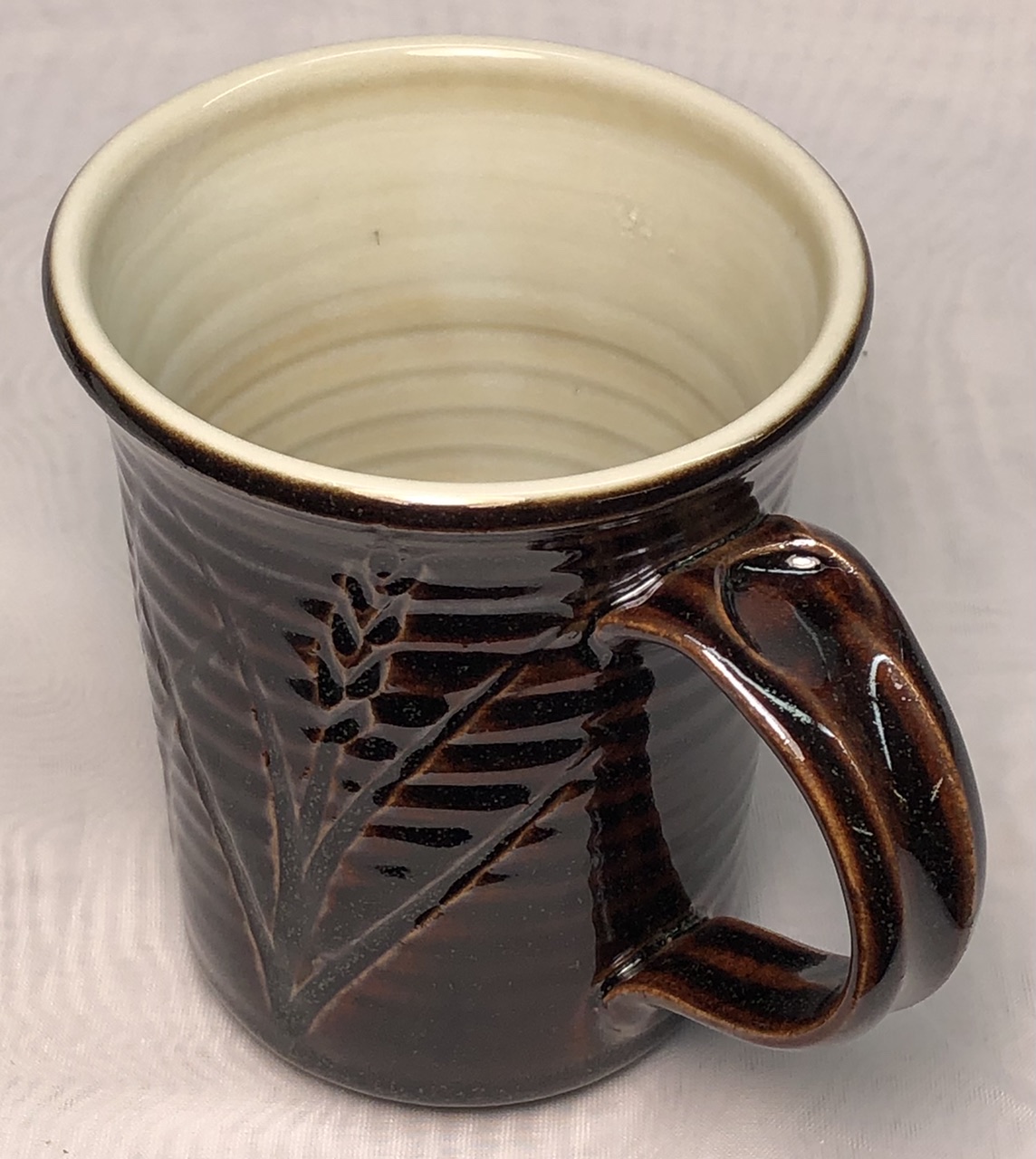Project Name
Develop a Better Cone 10 Transparent
Project Codenumber
UnAssigned
Notes
G1947U was developed from a transparent glaze originally used for porcelain insulator manufacturer (firing in oxidation). To create G1947U I changed that recipe to source CaO from wollastonite instead of calcium carbonate and added a little zinc to start melting earlier.
Over time it has become evident that G1947U is not as transparent as it could be (because of suspended microbubbles and likely unmelted grains of quartz). That is why it does not work well for underglaze decoration.
Switching to Grolleg or New Zealand kaolin has proven to give whiter results on white burning porcelains.
We have traditionally used 200 mesh silica, it seems logical 400 mesh would result in fewer undissolved particles (and better clarity). Fully dissolved SiO2 would lower thermal expansion and increase durability.
Sourcing KNaO and some of the CaO, Al2O3 and SiO2 from a frit should improve melt flow and produce a glass better able to dissolve quartz, pass gas bubbles and level to an ultra gloss. The little B2O3 it brings will give "a kick" to the melting process. A possible issue will be solubility in the frits causing rheology instabilities.
G1947U does craze on some bodies, so I believe it would benefit from a reduced thermal expansion. That will come from changes above, but would move down even more by trading a little of the CaO for MgO and increasing the SiO2. Both of these would otherwise impede melting, but the measures taken above to improve it should easily accommodate this.
G3910 has been done and produced excellent results. G3910A is working even better. But they have issues, as shown.
Cone 10/10R Transparent Base
|
Code # G1947U |
| Materials | Amt |
|---|---|
| Custer Feldspar | 27.000 |
| EP Kaolin | 20.500 |
| Silica | 26.500 |
| Wollastonite | 23.500 |
| Zinc Oxide | 2.500 |
Total:100.00
Auto Unity Formula
|
Si:Al: 9.2:1 6.5 (Molar:6.3) 3.1 |
Notes
This glaze can be used in oxidation or reduction for a crystal clear. It works well in reduction on whiteware bodies like Plainsman P580 and P590 and is also good on all other high temperature stonewares (even iron reduction).
Add Zircopax (up to 15%) for white, and stains for colors as desired. Colors however will be more subdued than at lower temperatures and some, such as chrome-tin pinks, may not work at all.
Add 2-15% iron for a whole range of celadon, brown crystal, tenmoku, kaki, translucent brown and crystaline glazes. About 11% is good for a tenmoku. If the iron fluxes the glaze too much, remove the zinc.
This glaze has been tested in high temperature oxidation and produces the same glossy transparent. However, on stoneware bodies with coarser particle sizes the surface can be slightly dimpled. It does not seem to make a difference whether the zinc is removed or not.
Some stains that work very well at this tempature are mason stains no. 6242,6464,6305,6319,6364,6134, and 14k139. I found it was better to apply the stain over the glaze then under.
Pictures
Ravenscrag GR10 variations outside, G1947U inside

Left mug inside: G1947U clear
Left & right mugs outside: GR10-CW White
Right mug inside: GR10-A transparent (pure Ravenscrag Slip)
Clay body is H550.
H550 with RavenTalc base, G1947U Transparent

The G1947U (right) really enhances the speckle. The GR10-C (left) mutes it much more and adds color.
G1947U, G3910 on H443 at Cone 10R

The fritted version on the right is pickup up the iron color and has less micro-bubbles, thus is more transparent.
G1947U, G3910 on H550 at Cone 10R

G1947U is more opaque, likely because it is hosting more micro-bubbles.
G1947U on H570 an H550 - Cone 10R

On H450, P600 at cone 10 oxidation

On H450, P600 at cone 10 oxidation
G1947U using Grolleg Kaolin

P700 porcelain P5797. Left: EPK. Right: Grolleg Kaolin (produces bluish color).
Typecodes
ST-Untitled typecode
Alternate Code Number:GS10-C
XML (to paste into Insight)
<?xml version="1.0"?> <recipes version="1.0" encoding="UTF-8"> <recipe name="Cone 10/10R Transparent Base" id="63912" key="WouvtpXr" date="2025-06-26" typecodes="ST" codenum="G1947U" picturebasename=""> <recipelines> <recipeline material="Custer Feldspar" amount="27.000" tolerance=""/> <recipeline material="EP Kaolin" amount="20.500" tolerance=""/> <recipeline material="Silica" amount="26.500" tolerance=""/> <recipeline material="Wollastonite" amount="23.500" tolerance=""/> <recipeline material="Zinc Oxide" amount="2.500" tolerance=""/> </recipelines> </recipe> </recipes>
Born: 1994-06-30, Modified: 2025-06-26 18:17:23
Fritted version of G1947U #1
|
Code # G3910 |
| Materials | Amt | |
|---|---|---|
| Ferro Frit 3110 | 28.500 | 23.75% |
| Calcined Kaolin | 12.500 | 10.42% |
| Ferro Frit 3249 | 4.500 | 3.75% |
| EP Kaolin | 18.500 | 15.42% |
| Silica | 35.500 | 29.58% |
| Wollastonite | 20.500 | 17.08% |
Total:120.00
Auto Unity Formula
|
Si:Al: 9.9:1 6.5 (Molar:6.4) 2.3 |
Notes
This changes G1947U as follows:
It sources KNaO from a frit
Using a calcined/raw kaolin combination
Switches ZnO for B2O3
Increases the SiO2
1500 powder, 1300 water.
Still very watery, had to add alot of epsom salts.
Melting much better. Much more transparent.
Pictures
G1947U, G3910 on H443 at Cone 10R

The fritted version on the right is pickup up the iron color and has less micro-bubbles, thus is more transparent.
G1947U, G3910 on H550 at Cone 10R

G1947U is more opaque, likely because it is hosting more micro-bubbles.
G3910 ball melt test (vs. G1947U)

G3910 Transparent flow test (vs. G1947U)

G1947U stains, G3910 does not

Felt pen, cleaned with acetone.
Cone 6 melt comparison G1947U/G3910

Cone 10ox comparison G3910/G3910

G3910+5% tin on P700 Cone 10ox

No crazing after several months.
Similar result with reduction firing.
At cone 10R the tin and non-tin version look the same.
Typecodes
ST-Untitled typecode
Alternate Code Number:GS10-C
XML (to paste into Insight)
<?xml version="1.0"?> <recipes version="1.0" encoding="UTF-8"> <recipe name="Fritted version of G1947U #1" id="186159" key="L7cD3PZw" date="2022-05-26" typecodes="ST" codenum="G3910" picturebasename=""> <recipelines> <recipeline material="Ferro Frit 3110" amount="28.500" tolerance=""/> <recipeline material="Calcined Kaolin" amount="12.500"/> <recipeline material="Ferro Frit 3249" amount="4.500"/> <recipeline material="EP Kaolin" amount="18.500" tolerance=""/> <recipeline material="Silica" amount="35.500" tolerance=""/> <recipeline material="Wollastonite" amount="20.500" tolerance=""/> </recipelines> </recipe> </recipes>
Born: 1994-06-30, Modified: 2022-05-26 18:25:10
Fritted version of G1947U #2
|
Code # G3910A |
| Materials | Amt |
|---|---|
| Ferro Frit 3110 | 21.800 |
| Fusion Frit F-69 | 3.600 |
| Grolleg Kaolin | 25.900 |
| Silica 400 mesh (Silica) | 32.100 |
| Wollastonite | 16.600 |
Total:100.00
Auto Unity Formula
|
Si:Al: 10.9:1 6.4 (Molar:6.4) 3.1 |
Notes
Changes G3910 as follows:
Switch from EPK to Grolleg kaolin
Switch to 400 mesh silica
Increase silica to get better ultragloss and reduce thermal expansion.
Used 2500water with 3000 powder.
Some crawling, needs some gum.
The first firing where this was tested was reduced heavily and not properly cleared in oxidation that the end (inadequate draft). So what appeared to be poor results on this glaze at the beginning was likely caused by that.
Stunning ultra-clear results on many pieces. Strangely, it was very sensitive to thickness over the black engobe.
Pictures
G3910A H550 mug

The glaze is ultra-clear, but this firing did not properly clear at the end, the lack of air flow left carbon on the insides of pieces like this. The early melting of this glaze might have been an issue, but likely not because the upper section is clear.
G3910A on H550 - some crawling

Lots of tiny crawls on the edges of the incised design. But this is the most transparent glaze I have ever seen at cone 10R.
G3910A on H550 - very good result

G3910A carbon trapping on P700

This is happening because reduction was too heavy and this melts very early.
G3910A over black slip, clouds where thick

This is likely happening because this firing was too heavily reduced.
L4476 H570 mug cone 10ox firing

Glaze is G2571D1 and G3910A
Cone 10ox firing, drop and hold firing but not slow cool.
G3910A crazed over time.
L4475B P600 cone 10ox mug

Glaze is G2571D1 and G3910A
Cone 10ox firing, drop and hold firing but not slow cool.
This crazed after a week.
Typecodes
ST-Untitled typecode
Alternate Code Number:GS10-C
XML (to paste into Insight)
<?xml version="1.0"?> <recipes version="1.0" encoding="UTF-8"> <recipe name="Fritted version of G1947U #2" id="188286" key="RBT4skH9" date="2021-11-09" typecodes="ST" codenum="G3910A" picturebasename=""> <recipelines> <recipeline material="Ferro Frit 3110" amount="21.800" tolerance=""/> <recipeline material="Fusion Frit F-69" amount="3.600" tolerance=""/> <recipeline material="Grolleg Kaolin" amount="25.900" tolerance=""/> <recipeline material="Silica 400 mesh" lookup="Silica" amount="32.100" tolerance=""/> <recipeline material="Wollastonite" amount="16.600" tolerance=""/> </recipelines> </recipe> </recipes>
Born: 1994-06-30, Modified: 2021-11-09 14:09:11
